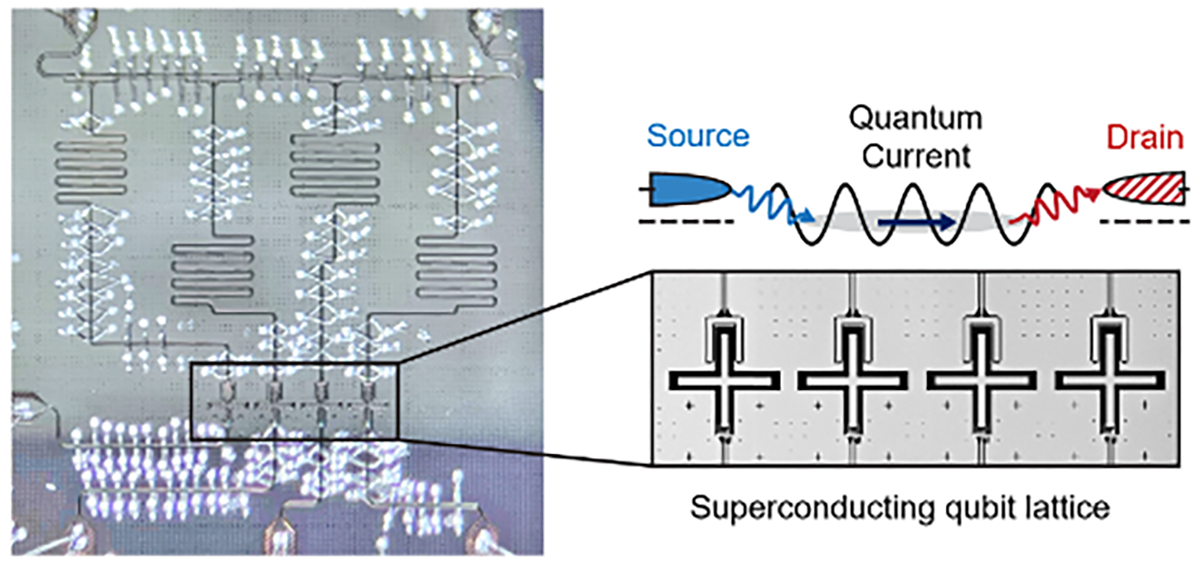Tracking Particle Motion in Synthetic Quantum Materials
2024-09-19
New methods to manipulate and detect particle current enable more versatile quantum simulators in superconducting circuits.

Physicists at Purdue University have developed an innovative method to detect the motion of individual particles in quantum materials. This work, led by Alex Ruichao Ma, assistant professor of Physics and Astronomy, offers new insights into the quantum world and paves the way for future discoveries in quantum science and technologies.
Understanding quantum transport—how particles like electrons move in materials—is crucial for developing advanced materials and better electronic devices. While much has been learned from measuring macroscopic current, i.e., the collective flow of many particles, physicists have lacked the technology to track the microscopic motion of individual particles in quantum materials. Synthetic quantum matter, engineered to exhibit specific quantum phases and behaviors, allows scientists to study and manipulate quantum phenomena in a controlled environment with unprecedented precision.

Botao Du, lead author of the paper and pictured in the middle above, is working with other graduate students in Ma’s research lab. Photo by Brian Powell.
Ma’s research team measured particle currents within a superconducting circuit lattice, a type of synthetic quantum matter. By controlling the particle number in the system, they observed how particle current and its quantum fluctuations change in different phases of matter – a first demonstration in synthetic quantum matter experiments. Furthermore, they generated complex particle motion by having the synthetic material interact with artificial particle reservoirs. They then applied the new current tracking method to study interaction-assisted quantum transport in a one-dimensional lattice.

Talking about the future of this research, Ma says, “We are working to apply this new quantum probe to study larger, more complex synthetic quantum materials. These findings will help us design new materials with novel properties and engineer better quantum computers.”
This work was recently published in Physical Review Letters: “Probing Site-Resolved Current in Strongly Interacting Superconducting Circuit Lattices”, Phys. Rev. Lett. 133, 060601 (2024). Graduate student Botao Du from Ma’s research lab led the experimental work. The authors acknowledge funding support from the National Science Foundation and the Air Force Office of Scientific Research. The superconducting qubit device used in this work was fabricated at Purdue’s Birck Nanotechnology Center.
Ma is a member of Purdue Quantum Science and Engineering Institute. This quantum discovery aligns with a key mission from Purdue University. Quantum science and engineering is one of four dimensions within Purdue Computes, a major initiative that enables the university to advance to the forefront with unparalleled excellence at scale.
Technical summary:
This work presents the first measurement of site-resolved particle current and current statistics in synthetic quantum matter, here in a superconducting circuit lattice. Our method utilizes controlled tunneling in double-well potentials to map in-situ current to on-site density. As applications of this method, we coherently prepare a strongly interacting Bose-Hubbard lattice at different particle densities and observe the change in current statistics as the system transitions from superfluid to Mott insulator phase. Furthermore, we develop a hardware-efficient implementation of tunable baths that serve as particle sources and drains. We observe current dynamics in discrete conduction channels and interaction-assisted transport in the bath-coupled lattice. By leveraging coherent control and engineered driven dissipation to generate many-body states and dynamics, we demonstrate a versatile setup for future exploration of out-of-equilibrium transport in open quantum systems using superconducting circuits.
About the Department of Physics and Astronomy at Purdue University
Purdue’s Department of Physics and Astronomy has a rich and long history dating back to 1904. Our faculty and students are exploring nature at all length scales, from the subatomic to the macroscopic and everything in between. With an excellent and diverse community of faculty, postdocs and students who are pushing new scientific frontiers, we offer a dynamic learning environment, an inclusive research community and an engaging network of scholars.
Physics and Astronomy is one of the seven departments within the Purdue University College of Science. World-class research is performed in astrophysics, atomic and molecular optics, accelerator mass spectrometry, biophysics, condensed matter physics, quantum information science, and particle and nuclear physics. Our state-of-the-art facilities are in the Physics Building, but our researchers also engage in interdisciplinary work at Discovery Park District at Purdue, particularly the Birck Nanotechnology Center and the Bindley Bioscience Center. We also participate in global research including at the Large Hadron Collider at CERN, many national laboratories (such as Argonne National Laboratory, Brookhaven National Laboratory, Fermilab, Oak Ridge National Laboratory, the Stanford Linear Accelerator, etc.), the James Webb Space Telescope, and several observatories around the world.
About Purdue University
Purdue University is a public research institution demonstrating excellence at scale. Ranked among top 10 public universities and with two colleges in the top four in the United States, Purdue discovers and disseminates knowledge with a quality and at a scale second to none. More than 105,000 students study at Purdue across modalities and locations, including nearly 50,000 in person on the West Lafayette campus. Committed to affordability and accessibility, Purdue’s main campus has frozen tuition 13 years in a row. See how Purdue never stops in the persistent pursuit of the next giant leap — including its first comprehensive urban campus in Indianapolis, the Mitch Daniels School of Business, Purdue Computes and the One Health initiative — at https://www.purdue.edu/president/strategic-initiatives.
Contributors:
Alex Ruichao Ma, Assistant professor of Physics and Astronomy at the Purdue University College of Science
Cheryl Pierce, Lead Marketing and Public Relations Specialist at the Purdue University College of Science